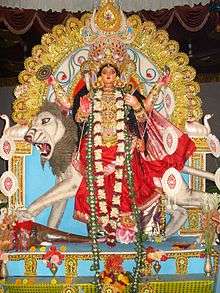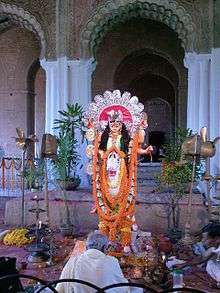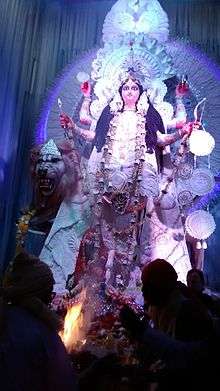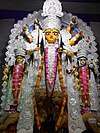Jagaddhatri
Jagatdhatri or Jagaddhatri (Bengali: জগদ্ধাত্রী, Devanagri: जगद्धात्री, Odia: ଜଗଦ୍ଧାତ୍ରୀ, 'Bearer of the World') is an aspect of the Hindu goddess Durga, who is particularly worshipped in the Indian states of West Bengal and Odisha. Her cult is directly derived from Tantra where she is a symbol of sattva beside Durga and Kali, respectably symbolized with Rajas and Tamas.
| Jagatdhatri / Jagadhatri | |
|---|---|
 Jagatdhatri Puja in Ramakrishna Mission TB Sanatorium, Ranchi | |
| Affiliation | Durga, Shakti, Adi Parashakti, Parvati |
| Weapon | Chakram, Bow, Arrow |
| Mount | Lion |
| Consort | Shiva |
Story
After creating goddess Durga all gods like Indra, Varun, Vayu and others thought they were very powerful. They thought they are almighty and can do anything with their power. So they forgot who is the real power of them. So Adi shakti took their test. She came before them as Maya and created a grass before them. She said, "Oh mighty deva's please take that grass". They were laughing, then Indra sent Vayu to take that grass out. Vayu tried and tried but failed. Every god one by one tried but failed. Then Goddess Adi Shakti came before them and told them that every power of this universe is her. She is the power of the whole world. So all the Gods understood their fault. Goddess came before them as Goddess Jagaddhatri sitting on a lion. And their ego became an Elephant. That's how we see Goddess Jagaddhatri sitting on a lion and an elephant under her.
Jagatdhatri Puja

The Jagatdhatri Puja was first started by Maharaja Krishnachandra of Krishnanagar, Nadia in Bengal. Jagatdhatri Puja is very popular in Krishnanagar, Tehatta, Rishra, Chandannagar, Bhadreswar, Hooghly, Boinchi , Ashoknagar-Kalyangarh. In Krishnanagar, Nadia, Raj Rajeshwary, Jagatdhatri Puja is one of the oldest Jagatdhatri Puja in Bengal. Legend has it that once during the Nawab raj in Bengal Maharaja Krishnachandra was arrested by Nawab Siraj-ud-Dullah for not paying tax in time. He was released from Prison during the day of Vijaya Dashami due to which the entire festivity of Durga Puja in his kingdom was spoiled so to again rejoice Maharaja started the ritual of this Jagatdhatri Puja, Jagatdhatri Puja was started. Primarily this puja was done by one Raj Rajeshwary ( Raj Mata ) Bengali language. and before start a Jagatdhatri Puja donate by Maharaja Krishna Chandra called Maa Jaleshwary at Malopara Barowary.
The Jagatdhatri puja of Bose family, Palpara, deserves a special mention in this regard. The puja of this family initially used to be held in their ancestral home in Murshidabad. Folklore has it that this puja was started in 1788. The puja was later shifted to its present location in Chandannagar, where many of the family members now live. The exact history of the deity is unknown, but family records date it back to 1640.

The beauty of the festival in Chandannagar is mainly due to the collaborative conception between the French and Bengalis. Remarkable feature remaining its procession, second largest in the world after Rio de Janeiro's, with its magnificent lightings[1]
Jagatdhatri figures in the semi-historical fictional work 'Anandamath' written by Bankim Chandra Chatterjee, from which book the national song of India "Vande Mataram" is taken. In the novel, Kali, Durga, and Jagatdhatri are depicted as three aspects of 'Bharat Mata' (Mother India) - Jagatdhatri as the mother used to be, Kali as the mother now is, Durga as the mother will be in future. The trio of goddesses are shown as the object of worship of a group of ascetics who form the protagonists of the story.
Jagadhatri Mela
After Ratha Yatra, Jagadhatri Mela at Bhanjpur Jagadhatri Podia, is the biggest mela of Baripada, Odisha. It is the festival of Maa Jagadhatri, Goddess of the whole world. There is an 8–15 days mela(carnival) also known as mini Bali Jatra named after Cuttack's Bali Jatra which takes place at Jagadhatri Mela Podia, Bhanjpur, near the Bhanjpur railway Station during the month of October–November. It is celebrated on Gosthastami. It is also referred to as another Durga Puja as it also starts on Asthami tithi and ends on Dashami tithi. The date of the puja is decided by the luni-solar Hindu calendar.
In 2012, the sarbajanina Maa Jagadhatri puja[2] has been started from 21 November. But the mela continued from 26 November to 7 December (for the first time it was for such a long period of 13 days). As the puja was celebrating its Diamond Jubilee for completing 60 years.
In 2013, the sarbajanina Maa Jagadhatri puja has been started from 11 November. But to commemorate the loss of Odisha, specifically Mayurbhanj district and Baripada due to Phailin and post Phailin flood, there will be no Cultural Program or Live telecast of this(2013) year's Jagadhatri Puja and Mela on Blue Sky (Local Cable Provider). But Mela will continue from 14 to 25 November 2013.
Every year its main attraction is the Puja Torana(Pendal) and the Mela. The Pendal is decorated as a famous monument like in 2011 it was a miniature of US Capitol Building, United States. This year, it is Lalitha Mahal, Mysore. From year 2000 it has been a tradition to decorate the torana as a special infrastructure. Tajmahal, Agra; Victoria Memorial (India), Kolkata; Titanic Ship; Lotus Temple, New Delhi; Golden Temple, Punjab etc. were also mimicked in the previous years since 2000 to 2006. As a tribute to 26/11 Hotel Taj Mahal Palace & Tower, Mumbai attack victims, the torana of year 2009 is a lookalike of that hotel. The pictures showing here are the toranas decorated from 2007 to 2012 as previous year's pictures are not available.
References
- "French connection: Jagatdhatri's homecoming to Chandernagore - Times of India". The Times of India. Retrieved 23 November 2016.
- Jagadhatri Puja and Mela, Bhanjpur on e-News Sites
Further reading
- McDermott, Rachel Fell (2011). Revelry, Rivalry, and Longing for the Goddesses of Bengal: The Fortunes of Hindu Festivals
External links
| Wikimedia Commons has media related to Jagaddhatri. |
- Jagaddhatri Puja posted by Suhit Das
- The Mela ground where Jagadhatri Mela takes place every year
- "Jagadhatri Mela kicks off with much fanfare" is the headline of e-news site webindia123.com as the famous Bhanjpur Jagadhatri Mela started on 21 Nov 2012
- How Chandannagar celebrates Jagadhatri Puja?: An article by Dr. Subhendu Prakash Chakrabarty

